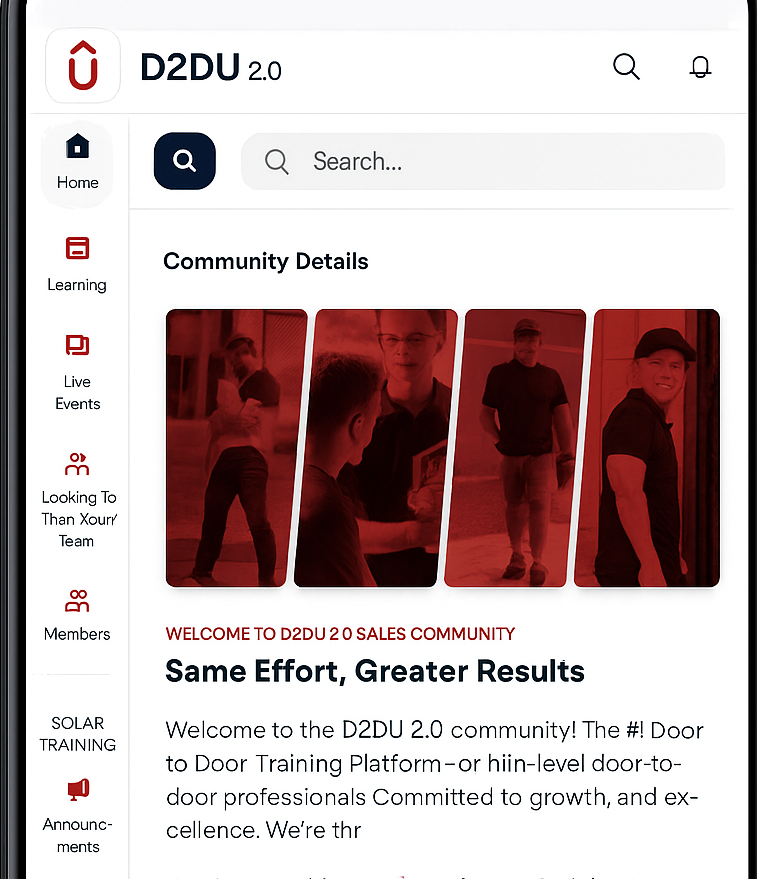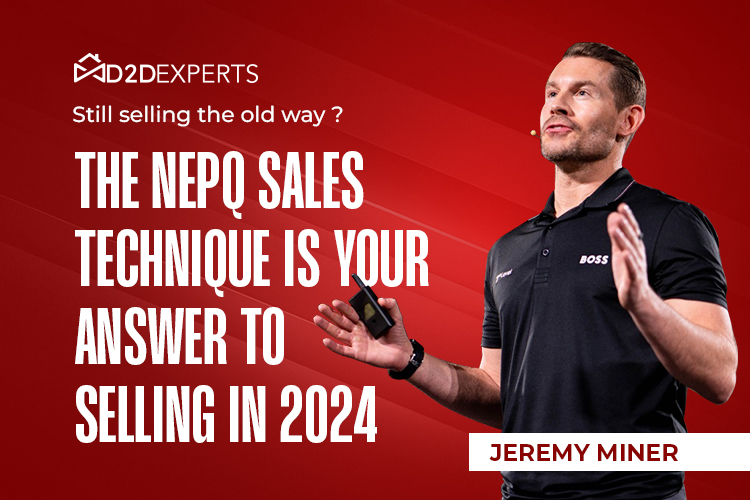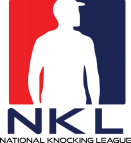The average American is exposed to 4,000-10,000 ads per day. That’s nearly double the number of ads the average person saw in 2007 and over five times as many ads as the average person saw in the 1970s.
Summary: Stop pushing products. Use Jeremy Miner’s NEPQ questioning technique to help prospects discover their own problems, making them want your solution naturally.
The average American is exposed to 4,000-10,000 ads per day. That’s nearly double the number of ads the average person saw in 2007 and over five times as many ads as the average person saw in the 1970s.
Feeling like doors got heavier this year? It’s not you, it’s your prospects drowning in ads. Their feeds are a firehose, their TVs are Times Square. You’re not competing with “no”—you’re competing with 10,000 “maybes.” Time to cut through the noise like a rep with fresh shoes and a tighter pitch.
Key Takeaways:
- Focus on Problem Discovery: NEPQ shifts from product pushing to helping prospects identify their own problems.
- Empathy & Curiosity: Building trust through genuine curiosity and empathy leads to better connections.
- Strategic Questioning: A structured set of questions uncovers hidden problems and creates urgency.
- Trust is Essential: Sales success relies on earning trust over time.
Long-Term Success: NEPQ fosters long-term relationships rather than immediate sales

The art of selling to an ‘unsellable’ generation
As Jeremy rightly points out in this podcast, people don’t want to buy anymore. The 21st-century consumer is aggressively protective of his dollars.
This means you will immediately get turned down when you offer them your product. Unfortunately, many door-to-door sales reps engage in what Jeremy calls “product pushing.”
Benefits of NEPQ vs Traditional Product Pushing
| Aspect | NEPQ Sales Technique | Traditional Product Pushing |
| Approach | Problem discovery through empathy and questioning | Forceful, persistent product pitches |
| Customer Engagement | Builds trust and opens up dialogue | Often leads to resistance or disinterest |
| Sales Process | Long-term relationship building | Short-term, pressure-based, often ending in rejection |
| Focus | Helps prospects realize their own problems and needs | Focuses on selling the product without addressing customer needs |
| Outcome | Leads to natural, informed purchasing decisions | Often results in “NO” or lack of trust |
Product pushing is a highly pressurized sales approach in which sellers attempt to force their product down the buyer’s throat.
Here, the seller keeps rambling about the project up and down, hoping to exhaust the buyer’s resistance.
Mistaken for positive persistence, these reps feel the more they hold on and stay in front of their prospects, the more their chances of selling.
But no, the best you can get from a homeowner who allows you to stay on his porch for so long is courtesy – not his dollars.
Ultimately, the rep is dejectedly washed with a barrage of NOs, ending in zero sales.
Studies show a strong positive link between how well a salesperson listens and how much the buyer trusts them. This aligns with the idea that empathy and active listening are key to building trust and closing deals, rather than aggressive product pushing. (Link to Source)
Jeremy proposes a far more practical solution: helping the buyer solve his problem.
Ahhh, we can hear you screaming this is a commonly recycled formula in door-to-door sales. But Jeremy adds a new spice: helping the buyers identify his problem.
Let us talk more about Jeremy Miner’s NEPQ sales technique.
Showing your prospective buyer his problem
The interesting thing about the 21st-century door-to-door sales industry is that you rarely meet a homeowner with a problem he has already discovered and wants to solve immediately.
Homeowners with pressing needs are likely to have solved them before you come around. They must have bought from your competitors or gone to the local store to satiate such need.
This is why the most reliable way to sell today is to help the homeowner identify a critical problem and intelligently establish that sense of urgency regarding why your prospect needs to solve that problem ASAP. This is what makes the NEPQ sales technique awesome.
You don’t create that sense of urgency by directly pressing the homeowner to buy NOW NOW NOW.
With Jeremy’s NEPQ sales technique, you ask a systematic set of questions that enable the homeowner to discover, “Oh shoot, I have a problem here!”
This can only be achieved when you patiently establish credibility with that prospect. Behavioral science in sales has firmly established that no one will contemplate buying from you when your legitimacy is in doubt.
NEPQ Questions to Ask Your Prospects
The first phase of the NEPQ sales method involves systematically disarming the buyer, making them relaxed and comfortable enough for you to open up.
Remember, you want to assist them in DISCOVERING their problem. As is typical of a discovery process, this requires some digging in.
Jeremy espouses starting the conversation with a mix of genuine curiosity and empathy. Then comes the connecting question.
NEPQ Questioning Phases
| Phase | Purpose | Example Questions |
| Connecting Question | Establishes rapport and shows empathy | “How have things been going for you lately?” |
| Situational Question | Understands the current situation of the prospect | “Can you describe your current situation regarding [problem]?” |
| Objective Question | Identifies the prospect’s desired outcome or goal | “What results are you hoping to achieve?” |
| Vacuum | Reveals the gap between current and desired state | “What’s holding you back from achieving this?” |
The essence of the connecting question is to establish you are interested in your prospect’s unique situation.
If you establish your concern about them, they will likely open up about their situation immediately before you for a diagnosis.
The connecting question is often tailed with the situational question. The situational question establishes the homeowner’s (in door-to-door sales) current situation, followed by the objective question.
The objective question projects where your prospect wants to be. Specifically, it identifies the results they aim to achieve.
Between the situational and objective questions is the vacuum you want your solution to fill. There is likely your prospect’s problem.
Real-World Scenario: How NEPQ Transformed a Sales Pitch
Imagine you’re a door-to-door solar panel sales representative named Alex. You’ve been using traditional sales tactics for years—pushing your product, talking non-stop about the benefits of solar panels, and hoping to wear down your prospects into saying yes. It’s been frustrating, with most doors closing before you even get a chance to finish your pitch.
One day, you decide to try Jeremy Miner’s NEPQ method. You’ve heard that questioning instead of pushing could change the game. So, you knock on the door of Mr. Thompson, a homeowner who’s previously turned you down twice.
Here’s how the conversation goes:
1. Starting with Empathy
You ask, “How’s everything going with your current energy setup? Have you noticed any challenges with your electricity bill lately?”
- Mr. Thompson opens up, explaining how his bills have been creeping up, but he hasn’t considered solar panels before.
2. Understanding the Situation
You then ask, “What’s your current electricity usage like during the summer months when the air conditioning is running?”
- He mentions that during peak summer, his energy usage spikes, but he’s unsure if solar would even be a viable solution for him.
3. Uncovering the Desired Outcome
Next, you inquire, “If you could reduce those summer energy bills significantly without worrying about upfront costs, would that be something you’d be interested in exploring?”
- This makes Mr. Thompson pause and think about the possibility of saving money long-term without heavy upfront expenses.
4. Identifying the Gap
By now, Mr. Thompson realizes he does have a problem with rising energy costs and sees how solar might be the solution. You ask him, “What do you think has kept you from exploring solar solutions before?”
- He admits, “I wasn’t sure it would really save me money, or if it was just another sales pitch.”
5. Creating Urgency
You gently nudge him: “Given that your energy costs are only going up, how much longer do you think you can keep paying these increasing bills before taking action?”
- Mr. Thompson acknowledges that he’s now seeing the urgency of solving the issue.
Rounding things up
Admittedly, as Jeremy envisages in the podcast, this NEPQ sales script (Neuro-Emotional Persuasion Questioning) doesn’t always happen in one day.
You would understand that you don’t gain someone’s trust in one day. This methodology is reliably built around persuasiveness and establishing trust.
But in the long run, the NEPQ sales technique is far more effective than “hoping” you could jump on doors and sell your prospects.
Join us at the D2D Business Bootcamp in Sandy, Utah, from April 22nd to 23rd. Our corporate executive coaching will explore integrating Jeremy Miner’s NEPQ sales technique into your team’s training and cultivating a winning sales culture.
Reserve your spot now and receive a free 30-minute video on Leadership and Recruiting.
FAQs:
What is NEPQ in sales?
NEPQ stands for Neuro-Emotional Persuasion Questioning. It’s a sales technique developed by Jeremy Miner that helps prospects discover their own problems through a series of structured, empathetic questions, rather than pushing a product on them. This approach builds trust and leads to natural, informed purchasing decisions.
How does NEPQ differ from traditional sales techniques?
Unlike traditional sales techniques that often rely on persistence and pressure, NEPQ focuses on understanding the prospect’s needs through strategic questioning. It aims to help the prospect recognize their own problems, creating a sense of urgency to solve them, rather than forcing a product onto them.
What kind of questions does NEPQ involve?
NEPQ uses a series of questions, starting with connecting questions to build rapport, followed by situational questions to understand the prospect’s current issues. Then, objective questions identify the prospect’s desired outcomes. This helps the prospect realize the gap between their current state and what they want to achieve.
Can NEPQ be used in industries other than door-to-door sales?
Yes, NEPQ can be applied across various sales industries, including B2B, retail, and service-based businesses. The core principle of understanding and addressing the prospect’s needs through empathy and effective questioning is universally applicable.
How long does it take to see results with NEPQ?
The results from NEPQ aren’t immediate, as building trust and rapport with prospects takes time. However, over the long term, NEPQ leads to more meaningful connections and higher-quality sales, making it a more sustainable approach than traditional pushy methods.
Join us as we chart a new course for success in the competitive sales world.
Hire fewer trainers, ship more wins
Build a sales machine that runs without you hovering

I knocked doors since I was 11! Never bought into the whole hourly normal job, and used direct sales to be the vehicle to create MASSIVE success. I Started the Direct Sales division for Solcius as their VP building it up to have 70+ sales reps nation wide. In 2018 I left to pursue a greater mission to unify and uplevel the Door to Door industry and founded the D2D Experts.
























